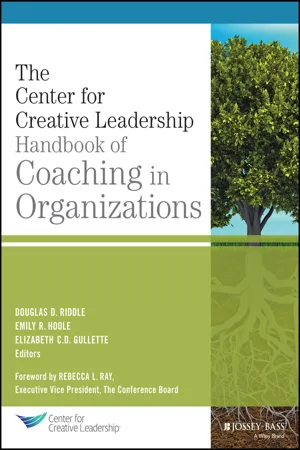
The Center for Creative Leadership Handbook of Coaching in Organizations
- English
- ePUB (mobile friendly)
- Available on iOS & Android
The Center for Creative Leadership Handbook of Coaching in Organizations
About this book
Effect better outcomes with a robust coaching program
The CCL Handbook of Coaching in Organizations deals with the practical, ethical, and political challenges of coaching within an organization. From coaching superiors to coaching business teams, this book outlines the Center for Creative Leadership (CCL) approach to professional coaching to help readers better manage leadership development and talent management program outcomes. With expert guidance on the key functions of human resources, learning and development, and organizational development, readers will gain insight into the issues associated with coaching program implementation and management, and the use of internal versus external coaches. Coverage includes a wide range of coaching-based services used in most large organizations, with practical advice on creating the right programs for maximum impact within the available budget.
Professional development is a hot topic and plays a key role in attracting and retaining the best talent. Coaching is a broad area within the field, encompassing a range of services and goals, with varied expectations and requirements. This book provides actionable guidance for those designing, initiating, and implementing coaching programs, with new approaches and techniques that drive better outcomes.
- Provide direct coaching within an organization
- Manage coaching systems and programs
- Initiate and lead mentoring and peer-coaching programs
- Manage external coaches, and deal effectively with coaching suppliers
An ideal coaching program must balance need with budget and be tailored to the requirements and resources of both the organization and the participants. It's a complex undertaking, but the right strategy and planning can lead to even better than expected outcomes. For the human resources professional who wants to strengthen an organization's coaching program, CCL Handbook of Coaching in Organizations is a thoughtful reference for a specialized function.
Frequently asked questions
- Essential is ideal for learners and professionals who enjoy exploring a wide range of subjects. Access the Essential Library with 800,000+ trusted titles and best-sellers across business, personal growth, and the humanities. Includes unlimited reading time and Standard Read Aloud voice.
- Complete: Perfect for advanced learners and researchers needing full, unrestricted access. Unlock 1.4M+ books across hundreds of subjects, including academic and specialized titles. The Complete Plan also includes advanced features like Premium Read Aloud and Research Assistant.
Please note we cannot support devices running on iOS 13 and Android 7 or earlier. Learn more about using the app.
Information
Part 1
Toward a Coaching Culture
Creating and Managing Coaching Programs
Chapter 1
The Rise of Coaching in Organizations
Note: Percentages do not add up to 100 percent due to rounding.

Exhibit 1.1
Research Insights: Impact of Leadership Development
- Retention
- Productivity
- Profitability
- Cus...
Table of contents
- Cover
- Title Page
- Copyright
- Dedication
- Foreword
- The Authors
- Introduction
- Part 1: Toward a Coaching Culture
- Part 2: Coaching Guidance for HR Leaders
- Part 3: Special Applications of Coaching
- References
- Name Index
- Subject Index
- About the Center for Creative Leadership
- End User License Agreement